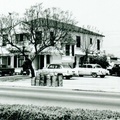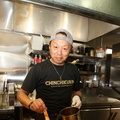Among the many events held by the Los Angeles Nikkei community in 2009, perhaps one of the most highly anticipated was the Tanabata festival. As part of this year’s Nisei Week Japanese Festival, the 1st Annual Tanabata Matsuri was held as a joint production of three community groups: the Nisei Week Planning Committee, Little Tokyo Public Safety Commission, and the Japanese Prefectural Association of Southern California. With the help of several other organization members and family members, over 250 tanabata ornaments were created to decorate the town, capturing the awe of all who attended the festival. After the festival, many of the participating organizations claimed ownership to the ornaments that each had made, taking them back to adorn the crafts at their respective facilities. However, one organization—the Japanese American National Museum (JANM)—decided to hold an event at a nearby beach to burn parts of the ornaments in a ceremonial “bonfire,” in hopes of “establishing a new tradition.” While the Tanabata Matsuri is already being hailed for successfully bringing together the English-speaking and Japanese-speaking Nikkei communities, perhaps JANM’s new tradition will also gain prominence as an event that connects the American community to the Japanese custom of “Otakiage ”.
100 tanzaku sent to Japan
At the conclusion of the Tanabata Matsuri, the seven ornaments that hung outside of JANM were taken down—but with nobody quite sure of how to dispose of them, museum staff members decided to store the ornaments in the museum for the time being. The museum’s ornaments were much larger versions compared to those created by other organizations, so figuring out a way to discard them was no simple task.
For starters, the ornaments were taken apart piece by piece—the structural framework, paper material used for Fukinagashi (streamers), etc.—until it came to a point where everybody thought, “Now what?” After discussing a number of possibilities, many began to agree on one of the options: “Why don’t we burn them?”
Burning something used for the tanabata event had actually already been done in the form of tanzaku (strips of paper used for decorating tanabata ornaments, each with wishes written on them by the creators). In June, a tanabata workshop was held prior to the festival, and the tanzaku made by the participants that day were collectively sent to a Zen temple in Shiga prefecture, Japan, and ceremoniously burned in an “Otakiage ” ritual. Around 100 tanzaku were sent to the temple. The head priest noted that a special ceremony was held since the “tanzaku were sent all the way over from America.”
Many disagreed with the decision, saying “Burning is out of the question,” or, “We put so much effort into them—we should keep them until next year.” In addition to the cost of making the ornaments, there was all the work put in to make 250 to 300 flower decorations for each of the ornaments to consider. It was not as if these concerns could be ignored.
However, Yoko Nishimura of Discover Nikkei pointed out that in Japan, it is customary and traditional to dispose of items used in a matsuri. Yet, no one could stand to simply throw away the ornaments, and since this is not Japan, a suggestion was made to integrate the disposal of the ornaments into a community event. The discussion was settled with a decision to hold a “bonfire” in the spirit of the Japanese tradition of “Otakiage .”
Evolving disposal methods
Until recently, it was customary in Japan to send tanzaku used for tanabata downstream in a river as a cleansing ritual, often called “tanabata-okuri ” or “tanabata-nagashi .” It was meant to carry their wishes to God, but the custom has started to die out due to concerns over environmental pollution. Nowadays most people dispose them as burnable trash in accordance with respective county regulations, especially in urban cities. Still, there are a wide range of people who stick with tradition and have them burned as “Otakiage ” at shrines and temples.
However, these are only examples regarding relatively small, household tanabata decorations. Many larger sized, public ornaments are known to be recycled, or donated for local residents to keep.
Sendai city, famed as the originator of the tanabata matsuri, takes down their tanabata ornaments immediately after their annual 3-day festival—but given the scale of funds and labor invested into their creations, the ornaments are rarely discarded as trash.
Over 3,000 ornaments are made for Sendai’s tanabata festival annually, but there are individuals and organizations all over Japan willing to take them after the festival. Most of the ornaments are put up for decoration again at their new destinations. Some are said to be donated to shopping malls as a good luck charm for prosperous business.
50 in attendance at the ceremony
The “Bonfire” event was held at Dockweiler Beach in Playa Del Rey, just near the Los Angeles International Airport. The beach has several fire pits, suitable for barbeques and large enough for a bonfire. There is no need for a permit to use them.
A pot-luck style barbeque started off the event, and later on, each person in attendance was to write their wishes onto individual tanzaku to burn away along with the ornaments. Since some parts of the ornaments were less flammable, more flammable portions of the ornaments—such as the Fukinagashi—were also cut into pieces for use as tanzaku to help feed the bonfire.
Around 50 people attended the event, including the “Discover Nikkei” team that spearheaded the tanabata project at the museum, as well as JANM employees, friends, and family members. One of the key organizers of the Tanabata Matsuri, Yoshihito Yonezawa of the Miyagi Prefectural Association, was also in attendance along with his wife, Junko. It was Yonezawa-san’s lifelong dream to organize a tanabata festival in Los Angeles, and he thanked the JANM staff or their support in helping realize the dream. Later, JANM’s John Esaki—after giving thanks to the attendees of the event—announced that “This is the first and only ceremony of its kind in North America,” and the crowd erupted in cheers and applause.
The event entered its highlight as people began writing their wishes on their tanzaku . Watching the bonfire flames against the dark ocean background, each person reflected upon the meaning of tanabata once again.
As the tanzaku
Of the tanabata burn
Night falls on the sea
Though this was the first event of its kind, even the core members of the Tanabata Planning Committee, such as Nancy Kikuchi, were in attendance. JANM has pledged their full support if the Tanabata Festival returns for an encore next year, and hopes to continue this newfound tradition for a second year.

© 2009 Yukikazu Nagashima





